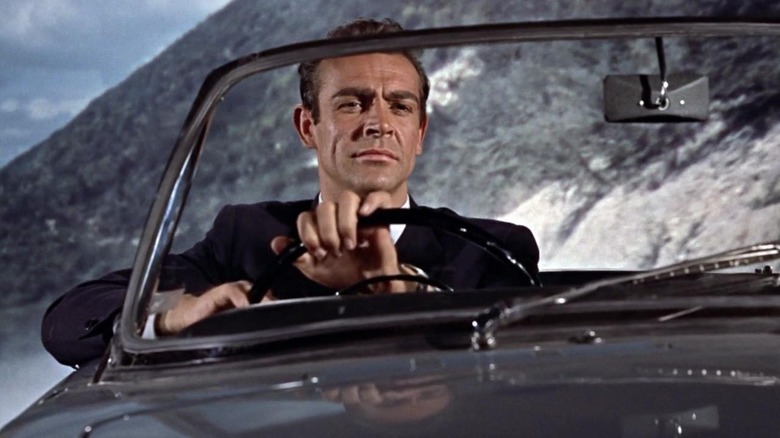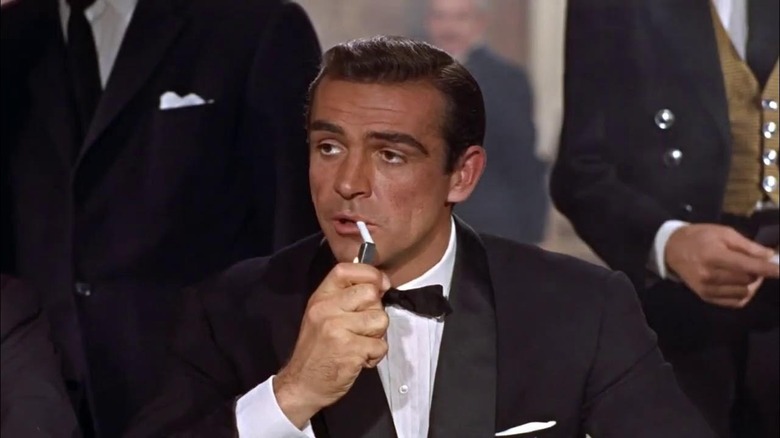Sean Connery Made Two Demands Before Agreeing To Become The First James Bond
There are few casting decisions in cinema history as important or impactful than that of Sean Connery as James Bond in "Dr. No." Ian Fleming's novels introduced us to the now-iconic MI6 spy 007, but it wasn't until 1962, when the first cinematic adaptation of those texts arrived, that the world at large came to know Bond, James Bond. Connery's casting is, perhaps, more than any other part of Terrence Young's seminal film, credited for its success. And even though Connery was a not terribly well-known actor at the time, he had a couple of demands that needed to be met before agreeing to take the part.
Published in 2015, Matthew Field and Ajay Chowdhury's book "Some Kind of Hero" chronicles the history of the "James Bond" films in great detail. In covering "Dr. No," the book contains an excerpt from an interview with Connery, who recalled how his journey as 007 began. It all started with legendary producer and franchise stalwart Albert "Cubby" Broccoli, who felt the actor might be a good fit for the part. After some discussion, Connery arrived at a couple of conditions:
"Broccoli called and said he had this Fleming film and thought I might fit the part. He asked me over and after we discussed it a bit further I said I would be interested provided they put some more humour into the story. I felt this was essential. He agreed, then said, when can you test? I asked what test? He said a film test. I said, sorry, but I'm not making tests. I'm well past that. Take it or leave it but no test."
Broccoli was amenable enough to include some humor in the film's script, which proved to be a very wise decision. But Connery was not willing to do a screen test. They either wanted him or they didn't.
'He was it from the beginning'
Despite the many other actors who were considered for the part, Connery ultimately became their guy. The rest is history. Broccoli, who along with Harry Saltzman largely made the "James Bond" movies what they were in those early days, understood that getting a capable yet relatively unknown actor for Bond was key. "If the books were successful, they would make whoever played Bond famous," Broccoli explains in the book. "A star couldn't have been tied up for a series of pictures; and we felt this to be vital."
That took already famous, perhaps more bankable stars off the table. But it didn't matter: "Dr. No" became a smash success, taking in $59.5 million worldwide against a $1 million budget. (For context, in today's dollars, we're talking about a movie making nearly ten times that amount.) That set up Connery for a run that would also include "From Russia With Love," "Goldfinger," "Thunderball," "You Only Live Twice," "Diamonds Are Forever" and, later, in an unofficial capacity, "Never Say Never Again."
Perhaps more importantly, the film's success carved a path for cinema's most enduring franchise, which has now spanned 60 years and six actors across 25 films. Connery is owed a great deal of credit for his part in all of it. In the book, associate producer Stanley Sopel may have said it best in explaining that they knew from day one that Connery was going to be their James Bond:
"He didn't look like anybody's idea of Bond when we first saw him but there was something there. We did go through the motions of screen-testing some fifteen or twenty hopefuls, of everybody's idea of what Commander Bond should look like: 6'2", British upper-crust, with the sort of chiseled face. Had a genius come out of that testing, Connery probably wouldn't have gotten the part, but he was it from the beginning."

